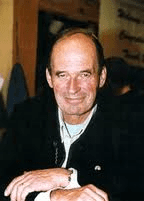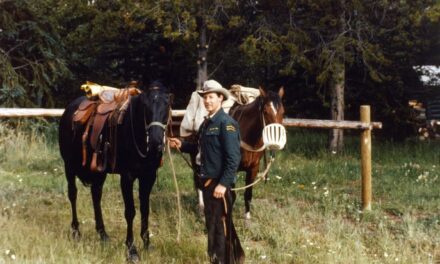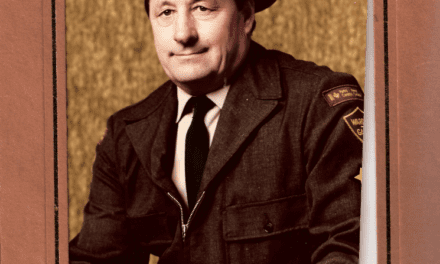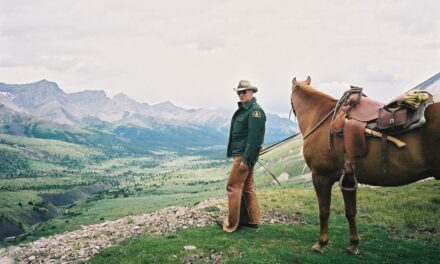SH: Or the snails
Dave: Or the snails (laughs), and there is the story. I didn’t know anything about the snails at the time but apparently there were unique snails there. Dave Hunter, who was doing environmental assessment type work at the time, told me that you’ve got to make sure you protect the snails in the environmental assessment. I committed a certain amount of money to protect the snails and do research, so we knew what we were protecting.
But the point that I wanted to make here was that an environmental assessment was a good vehicle for getting money to do good research and knowledge development in Parks Canada. The guy that was extremely good at that was Cliff White and he used environmental assessments to build a research program, where we really needed the information but didn’t have it.
SH: Big or small we protect them all.
Dave: Exactly. Let’s see I guess one of the best trips I had in the backcountry was with Cliff, Tom and Ian. That was just a terrific trip. We just had the nicest time doing park monitoring.
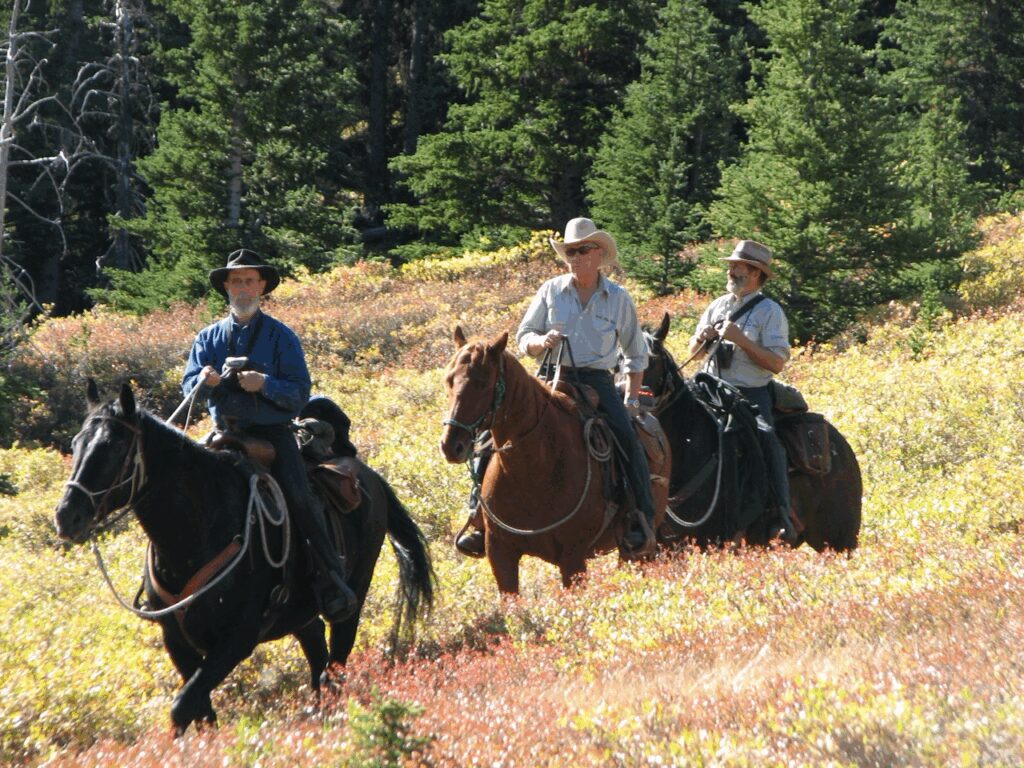
Dave, Ian Pengelly and Cliff White – Clearwater 2009
Dealing with wildlife management issues were in our purview, but early in the day we were developing the wildlife corridors around the Town of Banff. The management plan had set direction for the north side, the Minnewanka side of the highway, removing the paddock, removing the cadet camp, minimizing use of airport.
SH: The horse barns
Dave: Yes, the horse barns were moved as part of that corridor, along with closing the airstrip, removing the cadet camp and the bison paddock. That established a functional corridor, probably the first example of corridor restoration in the world, according to Harvey Locke. But the south side of town was really important too, and that’s where the middle springs development was limited in terms of how far it was going to be permitted to go up the mountain. Wildlife needed to be able to move around the Town of Banff on that side of the mountain as well. In order to do that, certain activities had to be reduced, and we were working with the Manager of the Banff Springs Hotel at the time and he did not want his guests to have to travel very far to go dog sledding.
Dog sledding was happening on the golf course and it was quite a disruptive activity for wildlife movement in the winter. That activity needed to come out of the wildlife corridor. That was an exercise in communications in itself. We had to go to tender to re-design that opportunity in the park. The Hotel Manager said it can’t be more than fifteen minutes away, so we said, “Okay we’ll figure out a way to do that but it has to come out of that corridor and we have to close that golf course road” in the winter. So the golf course road was closed, the corridor was established and the dog sledding was retendered and moved to Tunnel Mountain Campground. So, we were able to work it up there for a while. The existing owners of the dog sledding operation didn’t like that, and when we went to tender, they lost the contract. That was very stressful because we didn’t know what we were dealing with there.
SH: And you had to prove success? Did you have success there?
Dave: We had success with the wildlife corridor, but the Tunnel Mountain Campground wasn’t a very good option for dog sledding. Now all that happens out on the Spray Lakes, based in Canmore and there’s dog sledding on the old 1A Highway in Lake Louise.
We’ve talked about the elk management strategy. That was a huge success in the end. The disappointing part about the elk management strategy was I was very keen to establish long term research. That’s how we really start to understand what’s going on in the ecosystem. We got a number of years out of it, but that funding was cut when the Warden Service was undergoing significant change.
I think I’ve talked about how the Warden Service changed over the years?
SH: Yes, you did a bit. You talked about women being involved and generalists.
Dave: Yes, the generalist warden that was able to do everything and contribute to the teamwork that was needed when the chips were down. A lot of that teamwork and connection with the park ecosystem was lost with specialization. I saw that change and that was a disappointing change I think for me. (Tape 8:47)
SH: How did your relationship with the Warden Service change over the years?
Dave: When I was in the ecosystem secretariat most of the guys in the Warden Service were colleagues. Quite a number of them were also part of our social network in Canmore. As I mentioned I see a number of these guys almost every day for coffee and whatever else we happen to be doing. I’ve got to talk about Scott Ward when we get to the retirement question.
SH: What about the Warden Service was important to you, and that could be in any role that you had, because I’m sure most people work for parks for similar reasons. But tell me what yours were.
Dave: The most important thing for me was moving science into decision making. That happened through the Warden Service and that created educational opportunities for the public, through the communications program, and to me, that was really what national parks were about. Creating those educational opportunities, because if national parks are to be set aside and nobody understands why, what have we accomplished in society? Bringing ecological integrity and science in decision making was really an importantly function to see happen. From that there were so many educational opportunities.
I don’t know how many media interviews I did, but each one of those was an educational opportunity.
SH: You were so involved with some of those huge conferences that attracted people from all over the world.
Dave: Yes, there was a lot of that kind of inter-agency and inter-governmental and international exchange. It was really such a healthy and engaging time. What was important in that was that the science, the research that was being done, provided an intimate working knowledge, and familiarity of park ecosystems and that to me was part of the whole business of knowledge creation, without which we can’t be legitimate park managers.
SH: Are there any legends or stories associated with the Warden Service that you can share?
There are legendary people in the organization. One of the things I learned from Scott Ward and Tim Auger in particular, was when the shit hits the fan, keep your head down. These guys were consummate, excellent at their jobs. Scotty as the dogmaster for seventeen years and a backcountry warden, did an excellent job and there was nobody finer in the day at public safety than Tim Auger. He was a leader in that whole public safety business, always innovating. But those guys liked their jobs and they were smart enough to know, that it wouldn’t be good for them to get a better paying job in the organization. Such an important lesson.
I worked with a variety of other people. There’s a Park Warden in Prince Albert National Park, a really genuinely nice guy, Eric Bell. Eric was an Indigenous guy that developed in consultation with all the chiefs and councils in the area, and we had quite a few First Nations around Prince Albert National Park, an Aboriginal Employment Equity program. I was thrilled with the work that Eric was doing …. a real eye opener and really important for the park to be more closely integrated with the First Nations communities in the area. It was really important stuff to try to reflect, in the composition of park staff, the composition of the surrounding population.
SH: Is there anyone else that stands out in your mind?
Dave: I mentioned Jillian Roulet, Doug Hodgins, Paul Galbraith, Greg Fenton. There’s a bunch of people in terms of people that stand out. I mentioned Heather Dempsey was the conscience …. She was fabulous, a really excellent employee for National Parks.
SH: Is there anything about the Warden Service, as you knew it, that you would want future generations to know?
Dave: As maybe some of the guys would say “It was a damn fine outfit.” This was a broadly capable group of generalists, and specialists who pulled together when adversity struck. Their teamwork was superlative. There’s always exceptions but they were an admirable part of the pride of the organization. Through the national parks, they provided a strong national identify. They were broadly supporting of each other across the country, and they had the expertise and capacity for problem solving.
SH: What made the Warden Service such a unique organization?
Dave: I guess one of the things you can say about the Warden Service is across the country, they were all different, but they all held very strong park values. They were uniquely adapted to the environments that they were protecting, but they still had a strong national identity.
SH: Good answer. Do you have any lasting memories as an associate with the Warden Service?
Dave: Every trip in the park was really an important memory for me. Another one, Park Galbraith and I were out on horseback in Prince Albert. We had a free roaming herd of bison in the southwest part of the park that had been there for quite a long time and was gradually growing. It still is today. There was a warden down there that had worked with the local farmers and businesses to gain their support so those bison could actually wander out of the park, wallow in their wheat fields, and wander back in, and they would be left alone.
The First Nations were still able to shoot them outside the park, and it happened occasionally, but these bison were pretty well protected. Paul and I went down there one day to see what was happening in the sedge meadows. How the sedge meadows were doing, were they being overgrazed, that kind of thing. So we were on horseback and we tied up the horses and decided to walk in. As we walked in, probably a couple hundred feet from the horses, there was a bison that had bedded down, and exploded up out of the brush in front of us and took off at full speed in the opposite direction. I tell you that gave me a start … 1500 pounds of bison, blowing up right in front of you. I thought this could be the end, but it worked out pretty good.
I have done a lot of boating and flying in the Parks and I guess in my career I was very fortunate to represent some operational sides of the Parks programs on national committees, and that allowed me to travel all over the country. That was very rewarding, and I loved doing that, but I didn’t like being away from Mary and the kids so much.
SH: What was your favorite Park when you got to travel around? Dave: Prince Albert was my favourite park. I enjoyed working in all of the different places that I have though. They’re all very, very different experiences, working in national parks, national historic sites, and heritage canals. These are very different places and very different components of the Parks program. I just wish I had an opportunity to work with the national marine parks because to me those are very interesting places and so much for us to learn and establish in terms of policy. It would have been very interesting work.
SH: Do you ever miss not being associated with the Warden Service?
Dave: I have coffee every day with a group of retired wardens and there are interesting stories being told all the time. (Tape 12:50)
SH: What year did you retire? What do you enjoy doing in retirement?
Dave: I retired in January of 2008 and going into retirement after being so busy was going to be quite a shock. The guy that recognized that right away was Scott Ward and Scott became my retirement mentor. He would drop out little things like the death of a good retirement is daytime television, little items like that. Scott and I skied in the winter every day after coffee. We would go for a ski, and he gradually reeled me in to coach biathlon. His son, Roddy, was the Canmore Nordic Ski Club coach for biathlon, but he needed some help to get the air rifles and things set up. I saw Scott hauling out these mats by himself and all the equipment, and I thought I could give him a hand. So, the next thing you know we are doing that every Tuesday and Wednesday through the winter. Scott gradually got more involved with The Wardens band and the next thing I know I’m doing this all by myself, which was great.
SH: I remember you and Scott also taught skiing up there. I remember Scott was an instructor and then people requested you be an instructor and that was when I was the registrar of the adult cross country ski lessons.
Dave: That’s right, I did this for the Canmore Nordic Ski Club and so I became a ski instructor, again under Scott’s mentorship. Then I took the qualification courses to be a CANSI instructor, the Canadian Association of Nordic Ski Instructors certified guy, and since then I have been teaching for Trail Sports as well.
SH: Oh, I didn’t know that. Good for you!
Dave: I’ve done a lot with Trail Sports and it’s fun and I love it. If I can pass on some passion for skiing, I love the chance to do that. So a lot of what I did in retirement was skiing and coaching biathlon, which I did for a good fifteen years. I’m still teaching skiing and coaching biathlon occasionally.
SH: You’ve helped out on the World Cups that I’ve been involved in.
Dave: Yes, I volunteer for a lot of different things up there, a lot of different races. I think in the early days it was Charlie Pacas, Jim Murphy and Scott Ward got me into all of that and I’ve continued to do it ever since. I have phased out of coaching biathlon, but I do a biathlon team- builder for K Country CO’s and Public Safety every year.
I built a shed at the cabin many years ago, and it was still standing. I thought maybe I could try renovating and building an addition onto the cabin, and I did that. It was still standing so I thought well maybe I could tackle the house in Canmore and so far, it’s still standing. So, renovations were a big learning experience for me and I love to learn new things.
I also took up stained glass making and have made windows of the East end of Rundle Mountain, Ha Ling Peak, Mt. Robson, the Front Range of the Rockies using a view from Scott Lake Hill, Hawk Ridge in Kootenay, a view from Canmore, AB to Wolf Lake in Manitoba, etc.
The other thing I’m still learning is cooking. The pandemic spurred that interest. Mary, for all those years with all the kids, was doing most of the cooking and now she’s enjoying my cooking, or at least surviving it. We also go down to our cabin in Ontario at Buckshot Lake every summer and the best part of all this is getting to spend more time with Mary and the kids.
SH: And grandkids.
Dave: Yes, our four grandkids. It is really fun to watch them growing up, and visiting at the lake. Our 3 daughters are all mountain girls and live within four hour drives from Canmore.
The other thing we’ve done that we really enjoyed a lot is traveling. Before I could start the renovations Mary knew that I would probably spend too much money and kill our chances of travelling, so we traveled first. Among many trips, we travelled with Scott Ward and his wife all through South America for two months, and that was a tremendous experience. We also joined Andree and Paul Galbraith for a trip to Haida Gwaii.
Another fun adventure for us was in 2017, the150th anniversary of Canada. We did an Arctic expedition up to Grise Fiord on Ellesmere Island, and that was a really wonderful trip.
SH: Wow, you really are well traveled.
Dave: Yes, Mary is the travel planner. I’m glad we did it, and I’m still very keen to travel all through Canada, so we’ll continue to do that.
SH: So, do you want to tell me about how you decided to retire?
Dave: Retiring was a hard decision to make. I’d been thinking about early retirement but hadn’t made any final choices. I went sailing with a friend and Scott Ward was on the trip and another fellow, a doctor. All of these guys were retired, and the guy that owned the boat was a pilot. He had lots of time off and seemed like he was retired, even though he was still working quite a bit.
So, we were sailing around the Gulf Islands and we had moored at an island, and these guys were going to go for a run. I hadn’t run for twenty years or more because I had injured an Achilles tendon. I thought I’m not going to just sit on the boat, I’ll go for a short run with these guys. I went for a half hour, and they went for forty minutes and I thought this is really great. You get a lot of time to think when you’re running and sailing. I was really enjoying the experience.
Scott and I were talking, and Scott was retired at the time so I’m thinking I could really get into a retirement program. Jillian was the Superintendent and in my view she was one of the best Superintendents this program has ever had. When I came back to the office from sailing, I went into Jillian’s office and said “I think I’m going to retire and I’d like to do if after I do the last National and Provincial Parks Council meeting which is at the end of October. I think Jillian was a bit surprised and I was too, but that’s how the decision was made.

SH: Wow, interesting.
Dave: Yes, it’s just the way things unfold.
SH: Is there anything I haven’t asked you that you think I should know about the Warden Service or Parks Canada?
Dave: We can choose to take many paths for our careers. I was very fortunate to have worked with Parks Canada in my career.
Susan Hairsine worked for Resource Conservation and Operations in Mt. Revelstoke/Glacier, Jasper and Banff National Parks, as well as for Public Safety in Western and Northern Region for over 30 years. She obtained funding for an oral history of Parks Canada’s avalanche personnel and oversaw the successful completion of the project. Her experience working with several the interviewees during their careers has been an asset to the current project. She was also the Executive Assistant to the Chief Park Wardens of Jasper and Banff National Parks.
